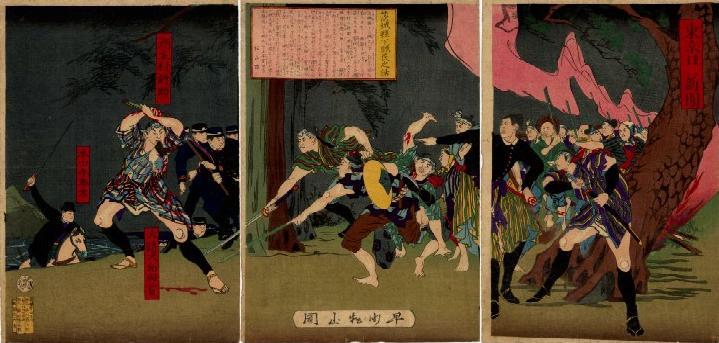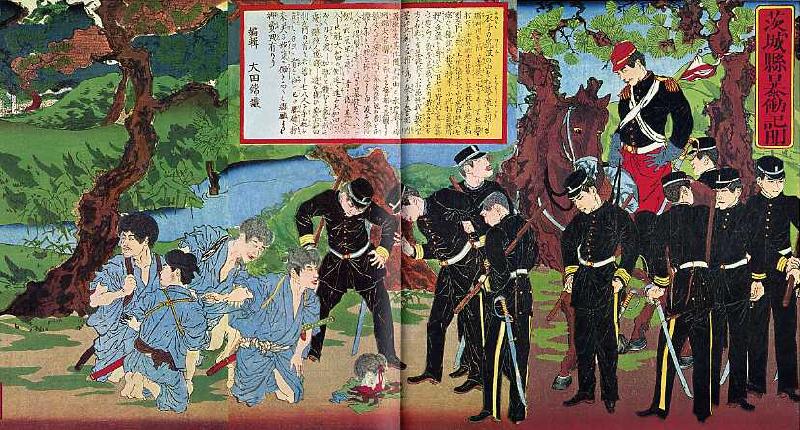Tokyo nichinichi shinbun TranslationStory of Ibaraki prefecture bandits and people Some bandits and people of Ibaraki prefecture, who are truly brimming with violence and threats, plan to rush the prefectural office. Shinsuke of Itaku village, who at the time had been serving a ten-year sentence, from the first had been a person of strong spirit [valor], and so is released from prison. [He] then comes and says he wishes to enter the gang of bandits. As [Shinsuke] was a man whose name had resounded and whose face had been known for some time, the insurgents knew nothing of the [government's] scheme. [Shinsuke] swooped on Owada Rizaemon, their leader, and cut off his head. The bandits, who were shocked by this, [Shinsuke] cut them away as they came within reach, and carrying [Owada's] head he gave [the fight his] do-or-die all and cut his way out. On dawn of the 20th he visited a magistrate, presented the head, reported the circumstances of the bandits, and was greatly praised. And so the stubborn bandits, shocked at having lost their leader, were captured or surrendered, and thus the bandits were subjugated. [Translated by William Wetherall] |
||
CommentaryThe drawing shows "Itaku village Shinsuke" teething by its hair the head of the insurgent leader "General Owada" while fending off Owada's followers -- and the gathered mob, armed with swords, hoes, and bamboo staffs. Prefectural councilor Honda, his bowler smart and sword ready, is galloping up behind a squad of police. Owada's cheeks are as blue as the steed's nose. Itaku village"Itaku village" is written 潮来村 and the characters 潮来 are marked to be read "Itaku". Some older texts represent this local name as 板来. The village is now the city of 潮来 -- pronounced "Itako". as the insurgents knew nothing"as the insurgents knew knothing" reflects しらなみの寄る (よる) かとすれば (shiranami no yoru ka to sureba" -- in which "shiranami" is an allusion to "bandits" in Chinese folklore, and a play on the a Japanese word meaning "don't know". See the gloss on "shiranami" in Man stops jumper for a closer look at the origins of the expression and its various meanings. | ||
Gingo and Ota versionThe story was told on other prints, including the triptych to the right, entitled 茨城縣暴働記聞 (Ibaraki-ken bōdō kibun) or "Ibaraki prefecture disburbance chronicled tidings", which was published in 1876. The picture was drawn by Shinshō Ginkō (真匠銀光, aka 安達吟光 Adachi Ginkō) and the story was written by Ōta Jōshiki (大田[金常]識). The title of the print indicates the story was a written account of something heard. The story on this triptych gives more details -- place names and dates, and notes that 7 or 8 people were arrested. It clearly describes the uprising as one of farmers led by Owada Rizaemon among others. The image shown here was scanned from Konishi, Volume 7, 1977:62-63. Konishi gives the name of the bandit leader as Ōmachi Kozaimon (大町小左衛門 Daichō? Shōzaimon?). According to Konishi's account, the prefecture had quelled an uprising the previous summer and now faced a new crisis. On the 6th of December, some 800 farmers from Nakagawa (那珂川 -- 那珂郡 Naka-no-koori, Naka-gun) gathered to present a request to extend the time within which they were required to pay taxes. Police intervened and they disbanded. On the 8th they again assembled, and hearing rumors that some of their members had been arrested when attempting to present their petition, they attempted to kill the two policemen who had come to break them up. On the 9th a thousand and several hundred farmers marched on the prefectural office in Mito. Prefectural authorities beefed up their police force with former Mito domain shizoku. The following day the prefectural force attacked the mob and send them running. The farmers attempted to reorganize at Abayamamura (阿波山村). The prefectural police infiltrated their ranks with several men released from a local prison, and that night the men assassinated their leader, Omachi Kozemon. The uprising was shattered. Some 1091 people were charged with offenses, including three who were executed. "Itakomura [sic] Shinsuke [who appears in TNS-9004] is one of the convicts who was contracted by the prefecture to assassinate the leader of the arising," according to Konishi (Ibid, page 62). |
Print information
Size oban triptych
Series: Tokyo nichinichi shinbun
Issue: No issue number (TNS-9006)
Notification date: 1876-12-25 (No banner)
Drawer: Hayakawa Tokunosuke (signed Hayakawa Shosan)
Writer: Shosan
Carver: Hori Yata
Publisher: Fukuda Kumajiro [Gusokuya]
Price: 6 sen
Images: Tsuchiya 2000 (TU), Yosha Bunko
Principal sources
Tsuchiya 2000
Konishi Vol. 7 (1977:60-61)
CCMA 2008

